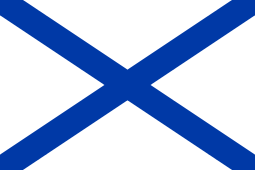Russian Naval Aviation
| Авиация Военно-морского флота Aviatsiya Voenno-morskovo Flota Russian Naval Aviation | |
|---|---|
 | |
| Country |
|
| Branch |
|
| Type | Naval aviation |
| Size |
28,000 personnel (2014)[1] Approx. 359+ aircraft[2][1] |
| Commanders | |
| Current commander | Major-General Igor Kozhin |
| Notable commanders | Major-General Timur Apakidze |
| Insignia | |
| Roundel |
 |
The Russian Naval Aviation (Russian: Авиация Военно-морского флота России, tr. Aviatsiya Voenno-morskovo Flota Rossii) is the air arm of the Russian Navy, having superseded the Soviet Naval Aviation. The Russian Navy is divided into four fleets and one flotilla: Northern Fleet, Pacific Ocean Fleet, Baltic Fleet, Black Sea Fleet, and Caspian Flotilla.
The air forces of the most important fleets, the Northern and Pacific fleets, operate long range Tu-142 anti-submarine warfare (ASW) aircraft and Il-38 medium-range ASW aircraft. Formations operating supersonic Tu-22M3 bombers were transferred to the Russian Air Force's Long Range Aviation in 2011.[3] The relatively small fleets, the Baltic and Black Sea, currently have only tactical Su-24 bombers and ASW helicopters in service. The small Caspian Flotilla operates An-26 and Mi-8 transports, Ka-27PS rescue helicopters, as well as some Ka-29 and Mi-24 armed helicopters. In 2011, the Russian Navy Deputy Commander-in-Chief for Naval Aviation and Air Defense/Commander, Naval Air and Air Defense Forces is Major General Igor Kozhin.
| Armed Forces of the Russian Federation |
|---|
.svg.png)  .svg.png) |
| Services (vid) |
| Independent troops (rod) |
| Other troops |
| Ranks of the Russian Military |
| History of the Russian military |
_DD-SD-99-06153.jpg)
Structure and Organisation
Structure in 2007
This is the structure of the Russian Naval Aviation, as reproduced from the August 2007 issue of the Air Forces Monthly.[4]
Northern Fleet Air Force – HQ Severomorsk
- 924th Independent Maritime Reconnaissance Aviation Regiment – HQ at Olenegorsk/Olenya - Tu-22M3;
- 279th Shipborne Fighter Aviation Regiment – HQ at Severomorsk-3 - Su-25UTG, Su-33;
- 100th Shipborne Fighter Aviation Regiment - HQ at Severomorsk-3 - MiG-29K;
- 73rd Independent Air Squadron – HQ at Kipelovo (Fedotovo) - Tu-142MK, Tu-142MR;
- 403rd Independent Mixed Aviation Regiment – HQ at Severomorsk-1 - An-12, An-26, Il-38, Tu-134;
- 830th Independent Shipborne Anti-Submarine Helicopter Regiment - HQ at Severomorsk-1 - Ka-27;
Pacific Fleet Air Force – HQ Vladivostok
- 568th Independent Composite Aviation Regiment – HQ at Mongokhto - operating Tu-22M3, Tu-142MR/MZ;
- 865th Interceptor Aviation Regiment – HQ at Yelizovo-Petropavlovsk-Kamchatsky Airport - MiG-31;
- 317th Composite Air Regiment – HQ at Yelizovo - Tu-142;
- 71st Independent Military Transport Air Squadron – HQ at Nikolayevka, Primorskaya - An-12, An-24, An-26;
- 175th Independent Shipborne Anti-submarine Helicopter Squadron – HQ at Yelizovo - Ka-27;
- 289th Independent Anti-submarine Air Regiment – HQ at Nikolayevka - Il-38, Ka-27, Ka-29;
Baltic Fleet Air Force – HQ Kaliningrad
- 689th Independent Fighter Aviation Regiment – Kaliningrad Chkalovsk - operating Su-27;
- 4th Independent Naval Assault Aviation Regiment – Chernyakhovsk Air Base - operating Su-24M/MR;
- 125th Independent Helicopter Squadron – HQ at Chkalovsk - operating Mi-8, Mi-24;
- 396th Independent Shipborne Anti-Submarine Helicopter Squadron - Donskoye Air Base - Ka-27/PS, Ka-29;
- 398th Independent Air Transport Squadron – HQ at Khrabrovo - An-2, An-12, An-24, An-26, Be-12, Mi-8.
Black Sea Fleet Air Arm – HQ Sevastopol (status in 2010) [5][6]
- 25th Independent Anti-submarine Helicopter Regiment - HQ at Kacha, Crimea - ~20 helicopters of types Ka-27 and Mi-14
- 917th Independent Composite Air Regiment - HQ at Kacha, Crimea - ~10x Antonov transport aircraft of types An-2, An-12 and An-26; 4x Be-12; ~10x Mi-8
- 43rd Independent Naval Shturmovik (Assault) Air Squadron - HQ at Gvardeyskoye, Crimea - 18x Su-24M; 4x Su-24MR;
Structure after 2008–2011 reforms
As a result of the 2008 Russian military reforms, the units of the Russian Naval Aviation were reorganized into 13 new Naval Air Bases. Each new naval air base consists of an HQ, support units and one or more aviation groups/wings (the former air bases). In a second stage, the air bases were merged into territorially integrated structures. Only the 279th Regiment retained its status. The planned transfer of Naval Aviation assets (Su-24, Su-27, Tu-22M3, MiG-31) to the Air Force has been delayed [7] due to their importance to the service, but was finally implemented by the end of 2011.
As of 2012, the only fixed wing strike and fighter aircraft of Russian Naval Aviation are the Su-33 fighters and Su-25UTG attack aircraft of the 279th Regiment (forming the Admiral Kuznetsov's carrier air wing), plus the Su-24 bombers based in the Crimea. This sole bomber unit remained part of Naval Aviation as an exception to satisfy treaty requirements governing Russian forces deployments on Ukrainian territory (these must be part of the Black Sea Fleet).[8] Buying brand new multirole Sukhoi Su-30SM for the Black Sea Fleet to replace Su-24 is in the planning stages.[9] Naval aviation also retains the anti-submarine aircraft of the forces (the Tu-142 and the Il-38) and the helicopter arm.
Naval air bases of the Russian Naval Aviation include:
Baltic Fleet air bases:
- Doiskoe NAB
- Chernyakhovsk NAB
- Chkalovsk NAB
- Khabrovo NAB
Black Sea Fleet air bases:
- Gvardiyskoye NAB
- Kacha NAB
- Novofedorivka NAB
Northern Fleet air bases:
- Kipelovo NAB
- Olenegorsk NAB
- Severomorsk-1 NAB
- Severomorsk-2 NAB
Pacific Fleet air bases:
- Elizovo NAB (Petropavlovsk-Kamchatsky Airport)
- Kamennyy Ruchey NAB
- Nikolaev NAB
Equipment
The Russian Naval Aviation maintains a large and varied fleet of fixed-wing and rotary aircraft. The most numerous being the Kamov Ka-27 anti-submarine helicopter that operates from various surface ships.
References
- 1 2 International Institute for Strategic Studies: The Military Balance 2014, p.185
- ↑ "World Air Forces 2015" (PDF). Flightglobal Insight. 2015. Retrieved 27 November 2015.
- ↑ air force monthly, January 2012
- ↑ Air Force Monthly 2007
- ↑ http://flot.com/news/navy/index.php?ELEMENT_ID=56395
- ↑ "Black Sea Fleet to get 18 new warships and renew naval aviation till 2020". Retrieved 24 December 2014.
- ↑ Moscow Defense Brief #2, 2011 p. 18-22
- ↑ "Ударные самолеты морской авиации передадут ВВС до конца года".
- ↑ "12 -30". Retrieved 24 December 2014.
External links
- Butowski, Piotr. Force Report:Russian Air Force, Air Forces Monthly, August 2007 issue.
- State of the Russian Air Force warfare.ru, Russian Military Analysis.